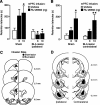Glucocorticoid effects on memory consolidation depend on functional interactions between the medial prefrontal cortex and basolateral amygdala
- PMID: 19906977
- PMCID: PMC2802541
- DOI: 10.1523/JNEUROSCI.3626-09.2009
Glucocorticoid effects on memory consolidation depend on functional interactions between the medial prefrontal cortex and basolateral amygdala
Abstract
Considerable evidence indicates that the basolateral complex of the amygdala (BLA) interacts with efferent brain regions in mediating glucocorticoid effects on memory consolidation. Here, we investigated whether glucocorticoid influences on the consolidation of memory for emotionally arousing training depend on functional interactions between the BLA and the medial prefrontal cortex (mPFC), a brain region involved in higher-order cognitive and affective processing. The glucocorticoid receptor (GR) agonist 11beta,17beta-dihydroxy-6,21-dimethyl-17alpha-pregna-4,6-trien-20yn-3-one (RU 28362) administered unilaterally into the left mPFC of male Sprague Dawley rats immediately after inhibitory avoidance training enhanced 48 h retention performance. An ipsilateral, but not contralateral, lesion of the BLA blocked the memory enhancement. In a second experiment, RU 28362 infused into the mPFC after inhibitory avoidance training increased BLA levels of phosphorylated extracellular signal-regulated kinase 1/2 (pErk1/2). Blockade of this pErk1/2 activity in the BLA with the mitogen-activated protein kinase kinase inhibitor PD98059 [2-(2-amino-3-methoxyphenyl)-4H-1-benzopyran-4-one] prevented the memory enhancement, suggesting that GR agonist administration into the mPFC enhances memory consolidation via modulation of BLA activity. Conversely, GR agonist infusions administered into the BLA posttraining increased pErk1/2 levels in the mPFC in regulating memory consolidation. Moreover, as assessed with a two-phase inhibitory avoidance procedure designed to separate modulatory influences on memory of context and footshock, posttraining GR agonist infusions into either the BLA or mPFC enhanced memory of the contextual as well as aversive information acquired during inhibitory avoidance training. These findings indicate that glucocorticoid effects on memory consolidation depend on bidirectional interactions between the BLA and mPFC.
Figures






Similar articles
-
The basolateral amygdala interacts with the medial prefrontal cortex in regulating glucocorticoid effects on working memory impairment.J Neurosci. 2004 Feb 11;24(6):1385-92. doi: 10.1523/JNEUROSCI.4664-03.2004. J Neurosci. 2004. PMID: 14960610 Free PMC article.
-
Basolateral amygdala-nucleus accumbens interactions in mediating glucocorticoid enhancement of memory consolidation.J Neurosci. 2001 Apr 1;21(7):2518-25. doi: 10.1523/JNEUROSCI.21-07-02518.2001. J Neurosci. 2001. PMID: 11264325 Free PMC article.
-
Glucocorticoids interact with the basolateral amygdala beta-adrenoceptor--cAMP/cAMP/PKA system in influencing memory consolidation.Eur J Neurosci. 2002 Feb;15(3):553-60. doi: 10.1046/j.0953-816x.2001.01876.x. Eur J Neurosci. 2002. PMID: 11876783
-
1999 Curt P. Richter award. Glucocorticoids and the regulation of memory consolidation.Psychoneuroendocrinology. 2000 Apr;25(3):213-38. doi: 10.1016/s0306-4530(99)00058-x. Psychoneuroendocrinology. 2000. PMID: 10737694 Review.
-
Systems mediating acute glucocorticoid effects on memory consolidation and retrieval.Prog Neuropsychopharmacol Biol Psychiatry. 2003 Dec;27(8):1213-23. doi: 10.1016/j.pnpbp.2003.09.015. Prog Neuropsychopharmacol Biol Psychiatry. 2003. PMID: 14659476 Review.
Cited by
-
Interactions between noradrenaline and corticosteroids in the brain: from electrical activity to cognitive performance.Front Cell Neurosci. 2012 Apr 9;6:15. doi: 10.3389/fncel.2012.00015. eCollection 2012. Front Cell Neurosci. 2012. PMID: 22509154 Free PMC article.
-
Aging and stress: past hypotheses, present approaches and perspectives.Aging Dis. 2011 Feb;2(1):80-99. Epub 2011 Jan 28. Aging Dis. 2011. PMID: 22396868 Free PMC article.
-
Top-down and bottom-up control of stress-coping.J Neuroendocrinol. 2019 Mar;31(3):e12675. doi: 10.1111/jne.12675. Epub 2019 Feb 1. J Neuroendocrinol. 2019. PMID: 30578574 Free PMC article. Review.
-
Long-term continuous corticosterone treatment decreases VEGF receptor-2 expression in frontal cortex.PLoS One. 2011;6(5):e20198. doi: 10.1371/journal.pone.0020198. Epub 2011 May 27. PLoS One. 2011. PMID: 21647420 Free PMC article.
-
Neural Signaling of Cortisol, Childhood Emotional Abuse, and Depression-Related Memory Bias.Biol Psychiatry Cogn Neurosci Neuroimaging. 2018 Mar;3(3):274-284. doi: 10.1016/j.bpsc.2017.11.005. Epub 2017 Nov 22. Biol Psychiatry Cogn Neurosci Neuroimaging. 2018. PMID: 29486869 Free PMC article.
References
-
- Akirav I, Maroun M. Ventromedial prefrontal cortex is obligatory for consolidation and reconsolidation of object recognition memory. Cereb Cortex. 2006;16:1759–1765. - PubMed
-
- Amat J, Baratta MV, Paul E, Bland ST, Watkins LR, Maier SF. Medial prefrontal cortex determines how stressor controllability affects behavior and dorsal raphe nucleus. Nat Neurosci. 2005;8:365–371. - PubMed
-
- Atkins CM, Selcher JC, Petraitis JJ, Trzaskos JM, Sweatt JD. The MAPK cascade is required for mammalian associative learning. Nat Neurosci. 1998;1:602–609. - PubMed
Publication types
MeSH terms
Substances
Grants and funding
LinkOut - more resources
Full Text Sources
Medical
